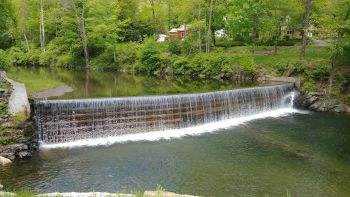Timber Dams

|
| The Green River Crib Dam is a historic timber crib dam built around 1811 in Guilford, Vermont, along the Green River.
(Image Credit: Connecticut River Conservancy) |
"Timber dams include all dams that rely on timber for structural support and include timber buttress dams, timber crib dams, and embankment dams with timber cribbing used as reinforcement to steepen the slopes. Timber faced rockfill dams that rely on the timber only to limit seepage, or provide erosion protection, and embankments that have wooden trestles buried in them do not rely on the structural integrity of the wood for stability and are not considered to be timber dams."[1]
"Many of the early dams in the United States were built with timber. These were generally small dams that were designed empirically. An early text by Wegeman (1905) discusses the following six types of timber dams:
- Brushwood Dams: Alternating courses of brushwood and gravel. Three- to five-foot thick courses of saplings and trees (with branches upstream) are sunk by placing stone and gravel on them. The dam was finished by covering the slopes with planking or rip rap.
- Log Dams: Horizontal courses of logs with several inches of saplings, brush, stone, and earth placed between them. The butt ends of the logs were placed downstream so that the dam had a triangular shape in cross section. The entire structure was covered with stone and earth.
- Pile Dams: Consisted of one to three rows of timber piles driven vertically across the river with logs and brushwood placed horizontally between or against the piles.
- Plank Dams: Formed by placing 2-inch by 12-inch by 12-foot planks to form vertical arches, convex upstream. Each course of planks was spiked or nailed to those beneath. On rock foundations, a single arch was used with the lower planks anchored to the foundation by iron bolts. On soil foundations, two arches were used with the space between filled with earth, gravel, or stone.
- Timber Crib Dams: Consisted of square timber cribs filled with stone or gravel. The cribs were constructed by placing layers of timbers spaced 6 to 10 feet apart at right angles to the previous layer. The structure was faced with wooden planks spiked into the timber cribs. If placed on rock foundations, the bottom course of logs was fastened to the foundation by iron bolts.
- Timber Buttress Dams: Deck and frame timber dams. Timber buttresses supporting a wooden plank face. These dams were typically spiked together. If founded on rock they were bolted to the rock with iron bolts. If placed on soil foundations, wooden sheet piling was driven vertically from the heel (upstream toe) to form a seepage cutoff." [1]
Timber dams are not recommended for long-term water storage due to the limited lifespan of timbers.
Best Practices Resources
![]() Engineering Guidelines for the Evaluation of Hydropower Projects: Chapter 10- Other Dams, FERC
Engineering Guidelines for the Evaluation of Hydropower Projects: Chapter 10- Other Dams, FERC
Revision ID: 7308
Revision Date: 07/18/2023
